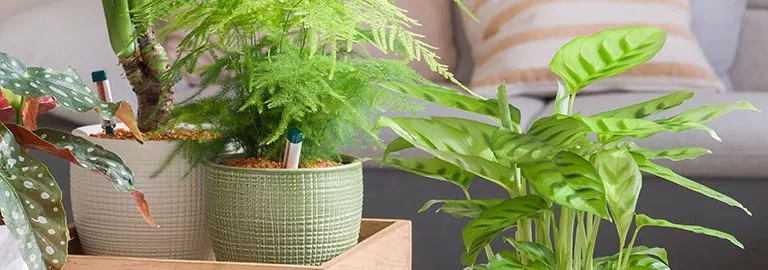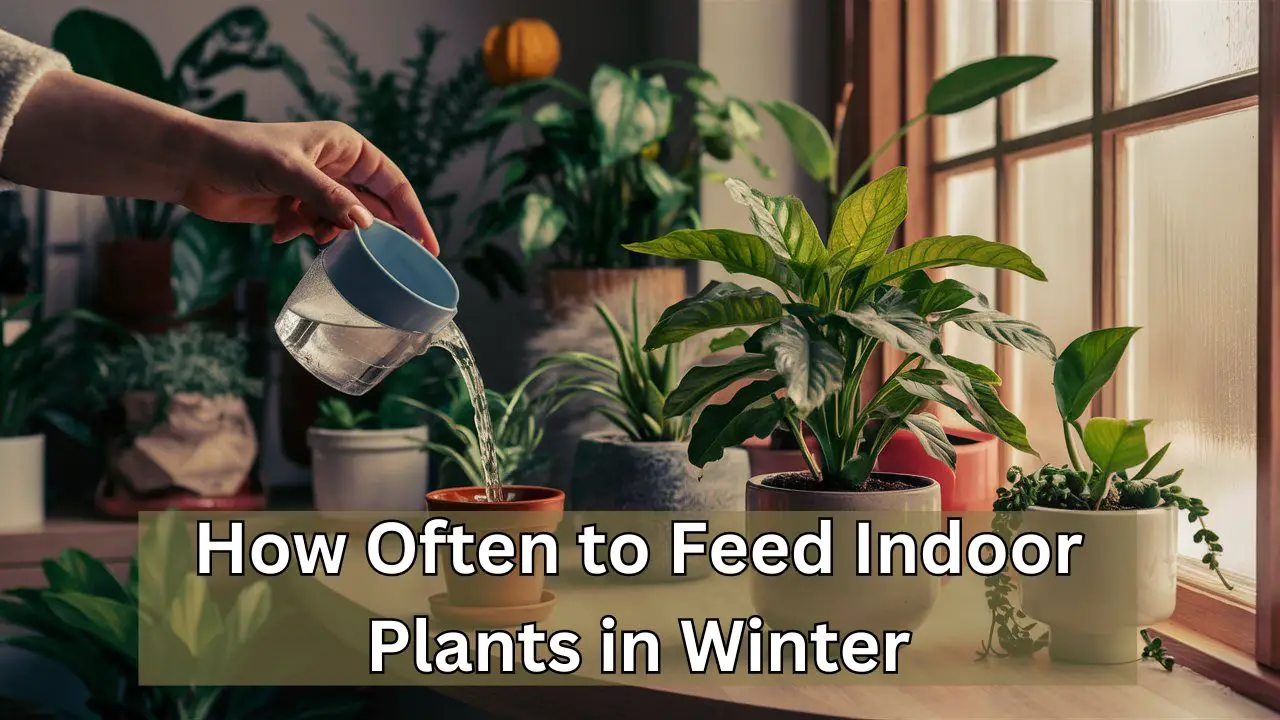Feed indoor plants once every 4-6 weeks during winter. They require less frequent feeding due to slower growth.
Indoor plants enter a dormant phase in winter, reducing their nutritional needs. Overfeeding can harm plants during this period. It’s essential to adjust your care routine to match their slower growth. Watering needs also decrease, so check soil moisture before watering.
Use a diluted, balanced fertilizer to avoid over-fertilizing. Indoor plants still need light, so place them near windows. Regularly dust leaves to maximize light absorption. Proper care ensures healthy, thriving plants even in winter. Monitor your plants’ health and adjust feeding and watering accordingly. This approach helps maintain vibrant indoor greenery year-round.
:strip_icc()/how-to-water-houseplants-5651236-primary-3aa1e5b5021640ee96184b6755caa964.jpg)
Credit: www.bhg.com
The Dormant Phase Of Indoor Plants
During winter, many indoor plants enter a dormant phase. This period is crucial for their survival. Understanding dormancy helps in providing the right care.
Winter’s Impact On Plant Metabolism
Winter’s cold temperatures and shorter days slow down plant metabolism. Plants need less water and nutrients. Reduced sunlight affects their growth patterns.
Metabolism changes cause plants to conserve energy. This helps them survive the harsh conditions. Proper care during this time ensures healthy growth in spring.
Recognizing Dormancy Signs In Indoor Plants
Recognizing dormancy signs is essential for appropriate care. Look for these signs:
- Slow or no new growth
- Yellowing or shedding leaves
- Reduced water uptake
- Wilting despite adequate watering
Understanding these signs prevents overwatering. Adjust your care routine accordingly.
| Sign | Explanation |
|---|---|
| Slow Growth | Indicates reduced metabolic activity |
| Yellowing Leaves | Shows energy conservation efforts |
| Shedding Leaves | Helps reduce energy consumption |
| Less Water Needed | Roots absorb less water |
Adjusting your care routine based on these signs ensures your plants thrive. Reduce watering frequency and avoid fertilizing during this phase.
Assessing Your Indoor Plant’s Needs
Understanding your indoor plant’s needs in winter is crucial. Plants go through changes during colder months. They need different care compared to other seasons. This section will help you assess your indoor plant’s needs effectively.
Factors Influencing Winter Feeding
Various factors influence how often you should feed your indoor plants in winter. These factors include:
- Plant Type: Some plants need more nutrients. Others need less.
- Growth Stage: Younger plants need more frequent feeding.
- Light Levels: Less light means slower growth. This affects feeding frequency.
- Temperature: Cooler indoor temperatures can reduce plant metabolism.
Monitoring Soil Moisture Levels
Soil moisture is a key indicator of your plant’s needs. Here’s how you can monitor it:
- Check the Soil: Insert your finger into the soil. If it feels dry, it may need water.
- Use a Moisture Meter: These tools give accurate readings. They help you know when to water.
- Observe Plant Behavior: Wilting or yellowing leaves can indicate moisture issues.
| Plant Type | Feeding Frequency (Winter) |
|---|---|
| Cacti and Succulents | Once a month |
| Foliage Plants | Every 2-3 weeks |
| Flowering Plants | Every 1-2 weeks |
Winter Feeding Frequency Guidelines
Feeding indoor plants in winter can be tricky. Plants need fewer nutrients during colder months. Overfeeding can harm them. Let’s explore how often you should feed indoor plants in winter.
General Feeding Intervals For Common Houseplants
Different houseplants have different needs. Some plants need more frequent feeding. Others need less. Here are some general guidelines:
| Houseplant | Feeding Interval |
|---|---|
| Fiddle Leaf Fig | Every 6-8 weeks |
| Spider Plant | Every 4-6 weeks |
| Peace Lily | Every 8-10 weeks |
| Snake Plant | Every 10-12 weeks |
| Aloe Vera | Every 10-12 weeks |
Adjusting Feeding Schedules For Plant Varieties
Some plants need special care in winter. Adjust feeding schedules based on plant type. Here are a few tips:
- Succulents: Feed every 12 weeks. Use diluted fertilizer.
- Tropical Plants: Feed every 6 weeks. Use balanced fertilizer.
- Flowering Plants: Feed every 4 weeks. Use high-phosphorus fertilizer.
Observe your plants closely. Check for yellow leaves or slow growth. These signs indicate overfeeding. Adjust the feeding schedule accordingly. Always read fertilizer instructions. Follow the recommended dosage for best results.
Nutrient Requirements During Colder Months
Indoor plants need special care during winter. The cold season can slow down their growth, meaning their nutrient requirements change. Understanding these changes can help keep your plants healthy all winter.
Essential Nutrients For Indoor Plants In Winter
Plants still need essential nutrients during winter, but their needs are different.
- Nitrogen: Less is needed as plants grow slower.
- Phosphorus: Helps with root health, still important.
- Potassium: Boosts overall plant health, needed in moderation.
Other micronutrients like calcium, magnesium, and iron remain important. Keep an eye on your plants for any signs of deficiencies.
Reducing Fertilizer Concentration
In winter, it’s crucial to reduce fertilizer concentration. Plants don’t grow as fast, so they need less food. Over-fertilizing can harm them.
Follow these simple steps:
- Mix fertilizer at half the usual strength.
- Feed only once a month.
- Use a balanced fertilizer with equal parts of nitrogen, phosphorus, and potassium.
Here’s a table for easy reference:
| Fertilizer Type | Winter Concentration | Feeding Frequency |
|---|---|---|
| Liquid | Half strength | Once a month |
| Granular | Half strength | Once every 6 weeks |
By adjusting the fertilizer concentration, you can keep your indoor plants healthy throughout the winter.
Watering Versus Feeding In Winter
Winter is a challenging time for indoor plants. The cold temperatures and shorter days can affect their growth. Understanding the difference between watering and feeding is key to keeping your plants healthy.
Balancing Hydration With Nutrition
During winter, indoor plants need less water. The cooler temperatures slow down their growth. Overwatering can lead to root rot. It’s important to check the soil moisture before watering.
Feeding, or fertilizing, is also different in winter. Plants need fewer nutrients during this season. Overfeeding can cause nutrient burn. Use a diluted fertilizer if you choose to feed your plants.
| Activity | Frequency | Notes |
|---|---|---|
| Watering | Every 2-3 weeks | Check soil moisture first |
| Feeding | Once a month | Use diluted fertilizer |
Avoiding Overwatering And Nutrient Burn
Overwatering is a common problem in winter. The soil stays wet longer due to lower evaporation rates. Check the soil by sticking your finger an inch deep. If it feels dry, water the plant.
Nutrient burn happens when too much fertilizer is used. The plant’s roots can’t handle the excess nutrients. This results in brown or yellow leaves. Always use a diluted fertilizer mix.
- Water less frequently
- Check soil moisture
- Use diluted fertilizers
By balancing hydration and nutrition, your indoor plants can thrive even in winter.
Optimizing Indoor Conditions For Winter Plant Care
Winter can be tough on indoor plants. The days are shorter, and the air is drier. Feeding indoor plants in winter requires special care. This guide will help you optimize conditions for your green friends.
Temperature And Humidity Considerations
Indoor plants need stable temperatures in winter. Keep the room temperature between 60-70°F. Avoid placing plants near heaters or drafts. Humidity is also crucial. Winter air can be very dry.
Use a humidifier to maintain humidity levels. Aim for 40-50% humidity. You can also place a tray of water near your plants. This will help keep the air moist.
| Temperature | Humidity |
|---|---|
| 60-70°F | 40-50% |
Lighting Adjustments For Shorter Days
Winter days are shorter, which means less light for your plants. Plants need light to grow and stay healthy. Move your plants closer to windows.
Clean the windows to let in more light. If natural light is not enough, use grow lights. Place the grow light 6-12 inches above the plants. Keep the light on for 12-14 hours a day.
- Move plants closer to windows
- Clean windows for more light
- Use grow lights if needed
Remember to adjust your plant care routine as seasons change. Your plants will thank you.
Common Mistakes In Winter Plant Feeding
Feeding indoor plants in winter can be tricky. Many plant owners make mistakes that harm their plants. Understanding these common errors helps keep your plants healthy during the cold months.
Overfeeding During Dormancy
Indoor plants often go dormant in winter. During this time, they require less food. Overfeeding can lead to root burn and other issues.
Signs of overfeeding include yellow leaves, wilting, and stunted growth. Be sure to adjust your feeding schedule in winter.
| Plant Type | Feeding Frequency |
|---|---|
| Succulents | Every 6-8 weeks |
| Ferns | Once a month |
| Flowering Plants | Every 4 weeks |
Neglecting Pest And Disease Checks
Winter is a time when pests and diseases can thrive indoors. Many plant owners forget to check their plants regularly. Common pests include spider mites, aphids, and fungus gnats.
Common diseases include powdery mildew and root rot. Regular checks help catch problems early.
- Look under leaves for pests.
- Check soil moisture to avoid root rot.
- Isolate infected plants to prevent spread.
Keep your plants healthy by avoiding these common mistakes. Adjust your care routine for winter and regularly check for pests and diseases.

Credit: www.gardenhealth.com
Expert Tips For Winter Plant Maintenance
Winter can be a challenging time for indoor plants. They need special care to thrive during the colder months. Here are some expert tips for winter plant maintenance.
Consulting With Horticulturists
Horticulturists can provide invaluable advice on winter plant care. Consulting with experts ensures your plants get the right amount of water. Too much water can lead to root rot. Too little water can dry out your plants.
Horticulturists know how to balance these needs. They can also recommend the best plant food for winter. Their advice helps keep your plants healthy all season.
Tailoring Care To Individual Plant Species
Different plants have different needs. Tailoring care to each species ensures optimal growth. Some plants need less water in winter. Others may need more humidity.
Here’s a quick guide for common indoor plants:
| Plant Species | Watering Frequency | Humidity Needs |
|---|---|---|
| Succulents | Once a month | Low |
| Ferns | Every week | High |
| Peace Lilies | Every two weeks | Moderate |
Succulents require minimal water and low humidity. Ferns thrive with frequent watering and high humidity. Peace lilies need moderate care. Adjust your plant care routine for best results.
Understanding each plant’s unique needs ensures they remain vibrant. Monitor the soil and adjust your watering schedule accordingly. Using a moisture meter can help.
Frequently Asked Questions
Should I Feed My Indoor Plants In The Winter?
Yes, feed indoor plants sparingly in winter. Use a diluted, balanced fertilizer every 4-6 weeks. Avoid overfeeding.
How Often Should Houseplants Be Watered In Winter?
Water houseplants less frequently in winter. Check soil moisture and water only when the top inch is dry.
How Often Should You Fertilize Your Indoor House Plants?
Fertilize your indoor house plants every 4-6 weeks during the growing season. Reduce fertilization in winter.
How Do You Keep Potted Plants Alive In The Winter?
Keep potted plants alive in winter by bringing them indoors. Water sparingly and provide sufficient light. Keep away from drafts and heat sources. Maintain humidity with a humidifier or misting. Monitor for pests regularly.
Conclusion
Feeding indoor plants in winter requires careful attention. Reduce feeding to once every month for most plants. Ensure they receive adequate light and water. Adjust care routines based on specific plant needs. Proper winter care ensures healthy growth year-round. Happy plant parenting!

My mission is to help you bring the beauty of nature indoors with expert advice, detailed plant care guides, and creative design ideas.




